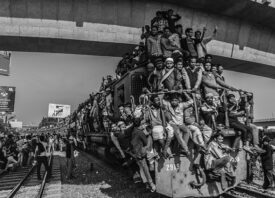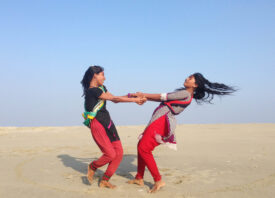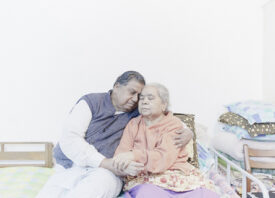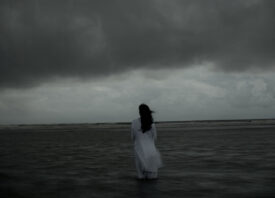Search this site
Documenting the Migrant Crisis in Bangladesh in Photos


Since August 2017, more than 700,000 people have fled Rakhine State, Myanmar to seek safety in Cox’s Bazar, Bangladesh. Theirs has been a treacherous journey, made all the more dangerous since arriving at sprawling camps on the unstable hillsides of Kutupalong, their lives put in jeopardy with every passing monsoon and cyclone season.
Many arrive injured, malnourished, and traumatized, these refugees live in structures made of bamboo, plastic, cardboard and sometimes corrugated metal sheeting. Heavy rain, flooding, landslides, cyclones, and water-borne illnesses are all real threats to the families living in these temporary homes.
With support from the American Red Cross, these families are now working to prepare for the onslaught of weather emergencies that continue to threaten their survival. Photographer Brad Zerivitz shares his experiences documenting the migrant crisis in this distant corner of the world.

How did you came to be involved photographing the aftermath of large-scale disasters for the Red Cross?
“Like many Americans, I associate the Red Cross with our nation’s blood supply, but when I started looking into jobs here, I realized the organization’s international work was incredible—and really appealed to me. In my four years with the organization, I’ve learned to love the mission, our place as a neutral actor, and the fact that Red Cross and Red Crescent’s presence in 191 countries makes it the world’s largest humanitarian network.
“I mainly work in video, so I typically travel the United States filming the Red Cross’s response to hurricanes, floods, and other emergencies. Because I love photography, I decided to shoot still photos alongside my videos. Once people saw my photos, they started asking me to shoot stills more and more often. My first international deployment as a still photographer with the Red Cross was to Nepal to document communities’ recovery from the 2015 earthquake. In the past few years, I’ve traveled to Kenya, the Philippines, Haiti, Bangladesh and Myanmar to document the Red Cross’s humanitarian work.
“I’ve been shooting still photography for longer than I’ve worked in video production, but I haven’t really publicized my work as a photographer. It’s been a fun challenge to deploy as a photographer and build a new type of portfolio.”

Could you speak about the challenges of making work where people are fighting for their lives, specifically in Bangladesh today?
“Shooting in displacement camps in Cox’s Bazar, Bangladesh offered so many challenges. The emotional toll—witnessing people in very dire circumstances— is the same one I face whenever I’m working in a disaster zone. I need to stay emotionally present enough to connect with individuals and their experiences, but I still have a job to do. It’s a difficult balance. There are a lot of emotions that get pushed aside when I’m working, but they all surface when I get home.
“Whenever I’m in a disaster zone, I’m amazed by people’s resilience. These families are going through some of the worst experiences of their lives, but they’re making the best of a terrible situation. In Bangladesh, migrants are living in flimsy huts made of bamboo and tarps, but they’re still eager to invite us inside, give us a shady place to sit and share their story.
“My writing partner, Jenelle Eli (Director of International Communications for the American Red Cross), and I have experienced incredible hospitality in places where people have lost everything and suffered serious trauma. It goes to show that people who are naturally warm, welcoming and kind will act that way regardless of their circumstances. Sometimes, the most valuable thing you can give to a person is your time and attention. They really appreciate having someone to listen to and care about their story. For my part, I try to capture the strength and dignity they bring to an almost unbearable situation.
“For example, a couple weeks ago, we met a woman named Sukutara at the displacement camp in Cox’s Bazar. She fled violence in her home country of Myanmar nearly two years ago. Her husband lost his life, but she arrived safely with her two young children. There isn’t a lot to do in the camps—people aren’t even allowed to work—so she decided to spend her time volunteering with the Red Cross to prepare her neighbors for natural disasters.
“She told us: ‘Volunteering brings me dignity. My community respects me because I serve them. I tell people how to strengthen their homes when a storm is approaching and how to stay safe. Being a woman, I have more access to women. They rely on me!’”

Could you speak about your connection with your subjects: do you engage with them on a personal level, or maintain detachment — and could you share how this choice of dis/engagement informs the way you work?
“It’s impossible not to connect with the people I’m photographing on a personal level. I’m inside their homes, listening to their stories and learning about their struggles. I wouldn’t be able to do my job if I didn’t have the chance to connect with people in that way.
“When I’m actually taking pictures, I need to disconnect—just a little—so I can focus on posing my subjects, capturing the best light possible and checking my camera settings, but emotion flows through both sides of the camera. I need to be emotionally present to capture their emotions. It’s the brief seconds when I move the camera away from my face and engage with my subjects that make or break the photos.
“I can’t imagine a way to remain detached and still capture emotion from my subjects. Even if it were possible, it wouldn’t feel right. These are real people with heavy, emotional life experiences. Staying present is necessary for me to honor their lives and their stories.”
What are you looking to capture and communicate in the photographs you make?
“Hope. I want people to feel hopeful when looking at my pictures. It’s what I feel when I hear Jenelle interviewing people and learning their stories. They’re going through terrible tragedies, but remain strong, resilient and hopeful for the future. It’s inspiring to see, so I work hard to make sure that my pictures communicate that feeling.”

How do you work to transcend the genre of “disaster porn” that informs so much of the way the West creates and consumes images of Third World nations?
“Glorification of pain is just not something I want to convey in my pictures. I’ve certainly seen sad, depressing scenes in disaster zones, but I’m not interested in photographing them. And the Red Cross wouldn’t be keen to promote that type of thing, either. I think that people who shoot those kinds of pictures do so because that’s what they’re trying to communicate. I approach my subjects looking for strength, hope, and resilience—I really think those feelings are reflected in my work.
“I understand why the news media is attracted to ‘disaster porn’—because it reinforces stereotypes about the developing world and gets more readers. But I want to reflect the reality: That more often than not, tragedy and disaster bring communities together. Recovery gives neighbors a common purpose. I see people emerge from disasters stronger and more resilient.”
How can photography help bridge the divide between the haves and the have-nots at a time when we are bombarded by scenes of devastation from every corner of the globe, so that we as storytellers can better serve both sides?
“It’s easy to feel hopeless when you’re bombarded with scenes of devastation. It’s easy to feel like there’s nothing you can do to help. If people take the time to read stories and look at pictures—like the ones Jenelle and I create—they will see that there’s a lot more to the story than what they see on the news. Americans just need to look for it. What we can do as storytellers is make sure that these kinds of pictures and stories are out there and that we share them with the world.
“We find amazing, hopeful disaster survivors wherever we go. We traveled to Myanmar after Bangladesh and met kids who survived a devastating cyclone. In response, they decided to learn first aid. Their families emerged from tragedy with a view of life that is kind of mind-blowing. I try to reflect that type of hope in every shot I take.”



All images: Brad Zerivitz © The American National Red Cross 2019



